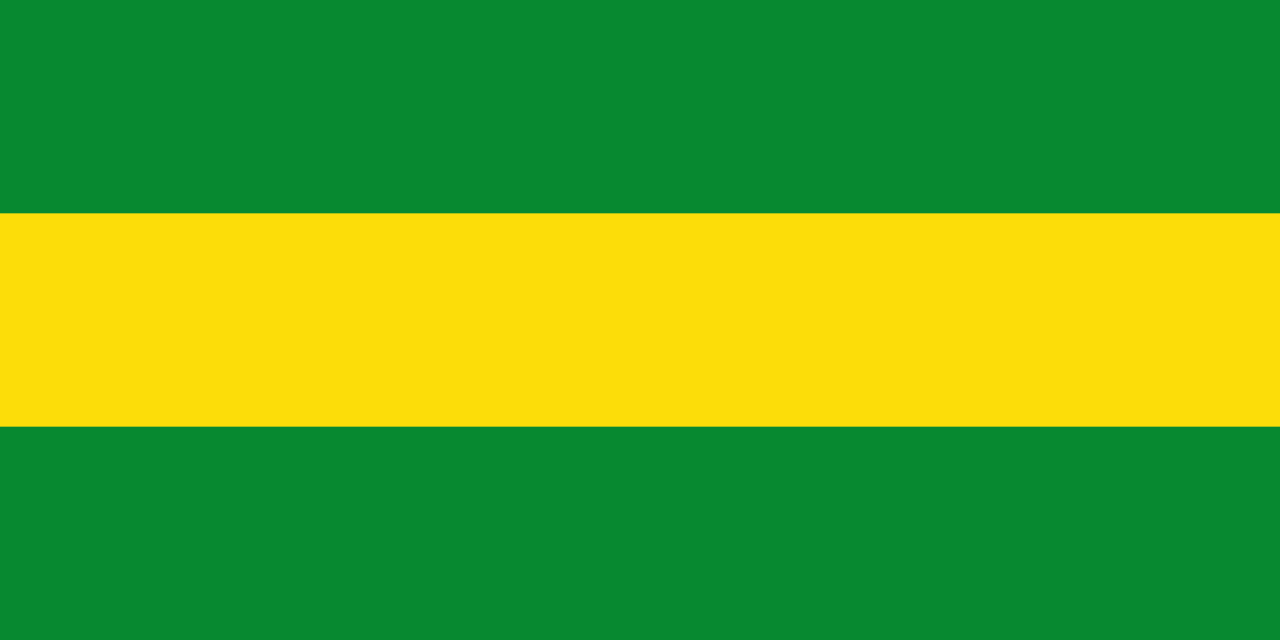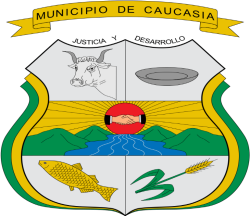CAUCASIA
Department
Antioquia department, Colombia.

Flag of the city
The flag of Caucasia is distinct with 2 colours. These colours are green, yellow, and green. The flag exhibits the city’s cultural heritage and values.

Seal of the city

Slogan of the city
The slogan “Justice and Development” encapsulates the core values and aspirations of the municipality. The slogan implies a holistic approach to community building. It suggests that the pursuit of justice is intricately linked with the overall progress and well-being of the community. This could involve fostering an environment where legal and social systems work in tandem to create a fair and thriving society.
History

Caucasia, nestled in the subregion of Bajo Cauca in the Antioquia department, Colombia, has a rich history that echoes through its landscapes and the vibrant spirit of its people. Established on April 12, 1886, with its official founding date recorded in 1945, the town owes its inception to the visionary Clemente Viloria Arrieta. Often hailed as the “Capital of Bajo Cauca,” Caucasia has emerged as a pivotal hub, strategically bounded by the department of Córdoba to the south, Nechí and El Bagre to the east, Zaragoza to the north, and Cáceres to the west, painting a portrait of connectivity within the tapestry of Antioquia. Situated approximately 270 km from the bustling city of Medellín, Caucasia has carved its identity as a vital center.
The town’s moniker, “Pantry Antioquia Livestock and Mining,” reflects its historical role as an agricultural and mining powerhouse, contributing significantly to the region’s economic landscape. Over the years, Caucasia has witnessed the ebb and flow of industries, adapting to the changing tides of economic priorities. In the realm of sports, Caucasia proudly hosts “Bajo Cauca F.C.,” a formidable presence in the Colombian Football Federation’s Second Division. This sports culture is deeply embedded in the community, fostering not only athletic prowess but also a sense of unity and pride. As Caucasia continues to evolve, its history remains an integral part of its present narrative. The town stands as a testament to resilience, adaptation, and the enduring spirit of its founders and residents, who have collectively woven the vibrant fabric of Caucasia’s past and present.
Geography of the city
Caucasia is a geographical marvel, bordered by the department of Córdoba and situated within the subregion of Bajo Cauca Antioquia. The municipality’s terrain unfolds as a flat expanse adorned with subtle ridges in the north, west, and south, creating a landscape that is both vast and diverse. As one of the largest municipalities in the area, Caucasia owes its prominence to its strategic location, positioned near the confluence of major tributaries that shape the region’s hydrography. The mighty river Cauca and the Nechí y Paramillo National Park converge in this territory, painting a picture of ecological richness.
Venturing into the rural expanses, Caucasia’s geography transitions into the Andean foothills, where elevations range from 50 to 500 meters. This unique confluence of the Paisa Region and the savannah regions of Colombia gives rise to the distinctive Chilapa culture, weaving together influences from contrasting landscapes. At the heart of this municipality, the mountain of Olvido stands as the pinnacle of altitude, reaching 502 meters in the township of Puerto Colombia. This elevation not only graces Caucasia with a geographic landmark but also provides panoramic views of the surrounding areas.

Etymology
The origin of the name “Cartagena” can be traced back through its linguistic roots. It is derived from the Spanish word “Cartagena,” which, in turn, finds its roots in Latin as “Carthāgō Nova,” meaning “New Carthage.” The Latin name itself has ties to the ancient Phoenician language, specifically the word “qrt-ḥdšt”, which translates to “Carthage” and can be literally interpreted as “New City.”
This etymological journey highlights the historical connections between Cartagena and the ancient city of Carthage, reflecting the city’s rich past and its role as a significant coastal settlement in Latin America.
Population
123,304 (2019)
125,000 (2023 projection)
One photo representative of the city

Etymology
The etymology of “Caucasia” in the Colombian context could be linked to local indigenous languages, historical figures, or geographical features.
What the city is known or famous for

Undoubtedly, the heart of Cartagena’s allure lies within its historic walled city, a captivating testament to its past. These formidable walls, originally erected to safeguard the city from relentless pirate incursions—an unwelcome consequence of its prosperity on the Caribbean Coast of South America—have a history steeped in the city’s foundation in 1543 and its pivotal role in the administration and expansion of the Spanish empire. By the early 1540s, Cartagena had firmly established itself as the primary conduit for trade connecting Spain to its burgeoning overseas dominions.
Throughout the colonial period, Cartagena emerged as a critical hub for the influx of African slaves and, notably, for the transportation of precious metals. Gold and silver sourced from mines in New Granada (comprising present-day Colombia and Panama) and Peru were loaded onto galleons destined for Spain, a lucrative endeavor that made the city a recurrent target for pirate raids.
In response to these ongoing threats, construction on a protective wall encompassing the city commenced in 1597. The ambitious endeavor, spanning almost two centuries, faced numerous setbacks from both tropical storms and pirate onslaughts. Ultimately, this massive fortification was completed in 1796, rendering Cartagena nearly impregnable.
The significance of Cartagena’s colonial walled city and fortress was internationally recognized in 1984 when they were bestowed the prestigious title of a UNESCO World Heritage Site. These grand walls, constructed primarily from coral, rise to a formidable height of 30 feet and boast a base thickness of 65 feet. Adorned with angled bastions—protruding sections designed to facilitate defensive fire in multiple directions—towers, and cannons, they stand as enduring guardians of the cities storied past.
